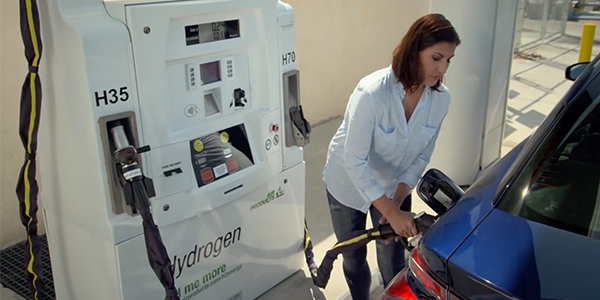The California Energy Commission allocated up to $116 million on Wednesday to install fueling stations for hydrogen-powered fuel cell electric vehicles with the goal of having 200 stations supporting 230,000 vehicles in the next decade.
The grants to three companies — Iwatani Corp. of America, FirstElement Fuel and Equilon Enterprises — could bring the total to 179 stations in the coming years, the CEC said.
Building hydrogen fueling infrastructure will help solve the “chicken-and-egg problem” of increasing the number hydrogen-powered vehicles, Commissioner Patty Monahan said. Hydrogen-powered cars from makers such as Toyota have been slow to arrive, but that is partly due to a lack of fueling infrastructure.
“What we’re seeing in California right now is, ‘Well, here’s your chicken, where’s the egg?’” Monahan said. “We want to see more fuel cell vehicles on the road.”
“We’ve got the infrastructure,” she said. “Now … show us the vehicles.”
Even with the new funding, hydrogen fueling stations and fuel cell electric vehicles likely will continue to make up only a small part of the state’s bid to get rid of polluting cars and trucks. California already has hundreds of thousands of plug-in electric vehicles and thousands of high-speed chargers available.
The state is aiming to have 5 million EVs on the road by 2030, requiring hundreds of thousands additional chargers in workplaces and public spaces such as shopping centers. (See California Needs Huge Number of EV Chargers.)
The CEC said, however, that the hydrogen stations will help meet Gov. Gavin Newsom’s order that all new passenger vehicles sold in the state must be zero-emissions vehicles by 2035.
Currently 45 hydrogen stations exist, mainly in Southern California, and 16 more are in development, the agency said. The grants will help build 111 new stations, bringing the total to 172. Seven more stations are under development using only private funds.
The $116 million, to be distributed in batches as the grantees meet specific milestones, will be paired with $131 million in private matching funds.
The new stations will also serve medium- and heavy-duty vehicles, potentially a big advance in reducing emissions, Monahan said.
Hydrogen fuel cell vehicles, which use oxygen and hydrogen to create electricity, have the advantage of being able to be fueled quickly on the road, much like gasoline-powered vehicles. But the expense of making hydrogen, which requires large amounts of electricity, and the difficulty of obtaining the rare and pricey vehicles, has thwarted widespread adoption.
Monahan said that could change if nations, including China and members of the European Union, support a “global scale-up.”
“We need a global transition to fuel cell electric vehicles to really be able to drive down costs and build up scale,” she said. “We’re trying to show in California how to do it.”




